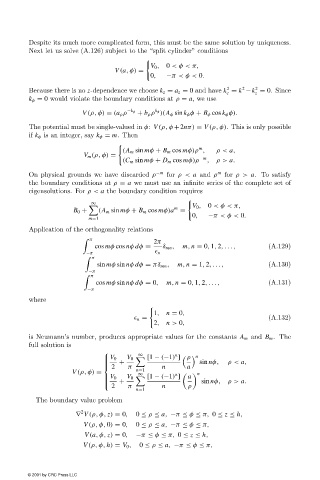Page 506 - Electromagnetics
P. 506
Despite its much more complicated form, this must be the same solution by uniqueness.
Next let us solve (A.126) subject to the “split cylinder” conditions
V 0 , 0 <φ <π,
V (a,φ) =
0, −π< φ < 0.
2
2
2
Because there is no z-dependence we choose k z = a z = 0 and have k = k −k = 0. Since
c z
k φ = 0 would violate the boundary conditions at ρ = a, we use
k φ
V (ρ, φ) = (a ρ ρ −k φ + b ρ ρ )(A φ sin k φ φ + B φ cos k φ φ).
The potential must be single-valued in φ: V (ρ, φ +2nπ) = V (ρ, φ). This is only possible
if k φ is an integer, say k φ = m. Then
m
(A m sin mφ + B m cos mφ)ρ , ρ < a,
V m (ρ, φ) =
(C m sin mφ + D m cos mφ)ρ −m ,ρ > a.
On physical grounds we have discarded ρ −m for ρ< a and ρ m for ρ> a. To satisfy
the boundary conditions at ρ = a we must use an infinite series of the complete set of
eigensolutions. For ρ< a the boundary condition requires
∞
V 0 , 0 <φ <π,
m
B 0 + (A m sin mφ + B m cos mφ)a =
0, −π< φ < 0.
m=1
Application of the orthogonality relations
2π
π
cos mφ cos nφ dφ = δ mn , m, n = 0, 1, 2,..., (A.129)
−π $ n
π
sin mφ sin nφ dφ = πδ mn , m, n = 1, 2,..., (A.130)
−π
π
cos mφ sin nφ dφ = 0, m, n = 0, 1, 2,..., (A.131)
−π
where
1, n = 0,
$ n = (A.132)
2, n > 0,
is Neumann’s number, produces appropriate values for the constants A m and B m . The
full solution is
∞ n
n
V 0 V 0 [1 − (−1) ] ρ
+ sin nφ, ρ < a,
2 π n a
V (ρ, φ) = n=1 n
∞ n
V 0 V 0 [1 − (−1) ] a
+ sin nφ, ρ > a.
2 π n ρ
n=1
The boundary value problem
2
∇ V (ρ, φ, z) = 0, 0 ≤ ρ ≤ a, −π ≤ φ ≤ π, 0 ≤ z ≤ h,
V (ρ, φ, 0) = 0, 0 ≤ ρ ≤ a, −π ≤ φ ≤ π,
V (a,φ, z) = 0, −π ≤ φ ≤ π, 0 ≤ z ≤ h,
V (ρ, φ, h) = V 0 , 0 ≤ ρ ≤ a, −π ≤ φ ≤ π,
© 2001 by CRC Press LLC

